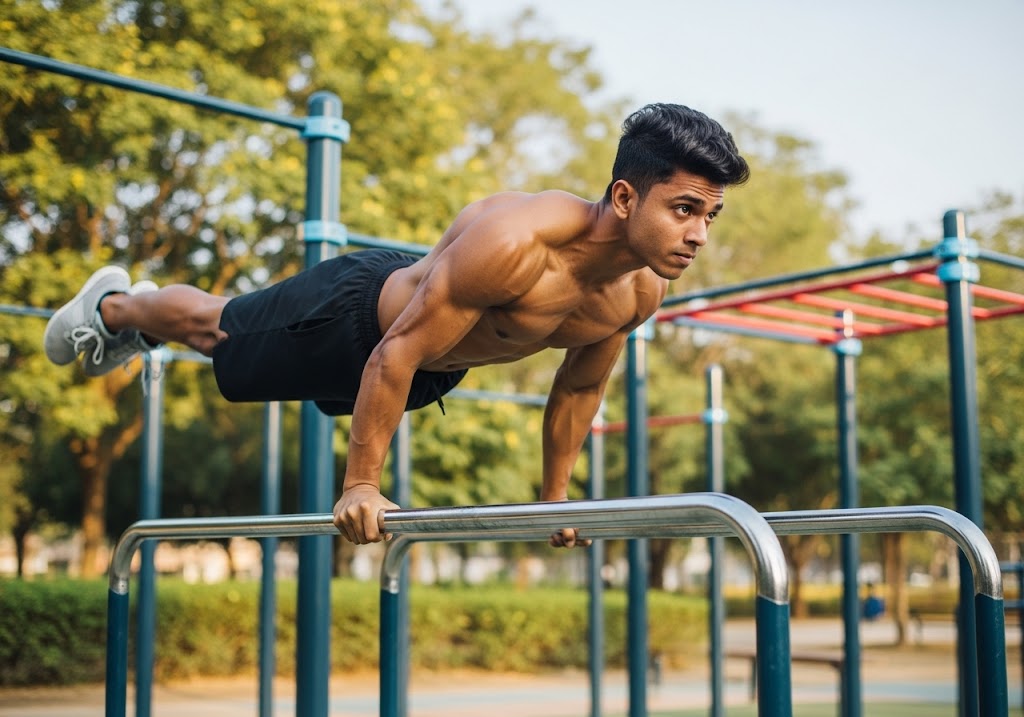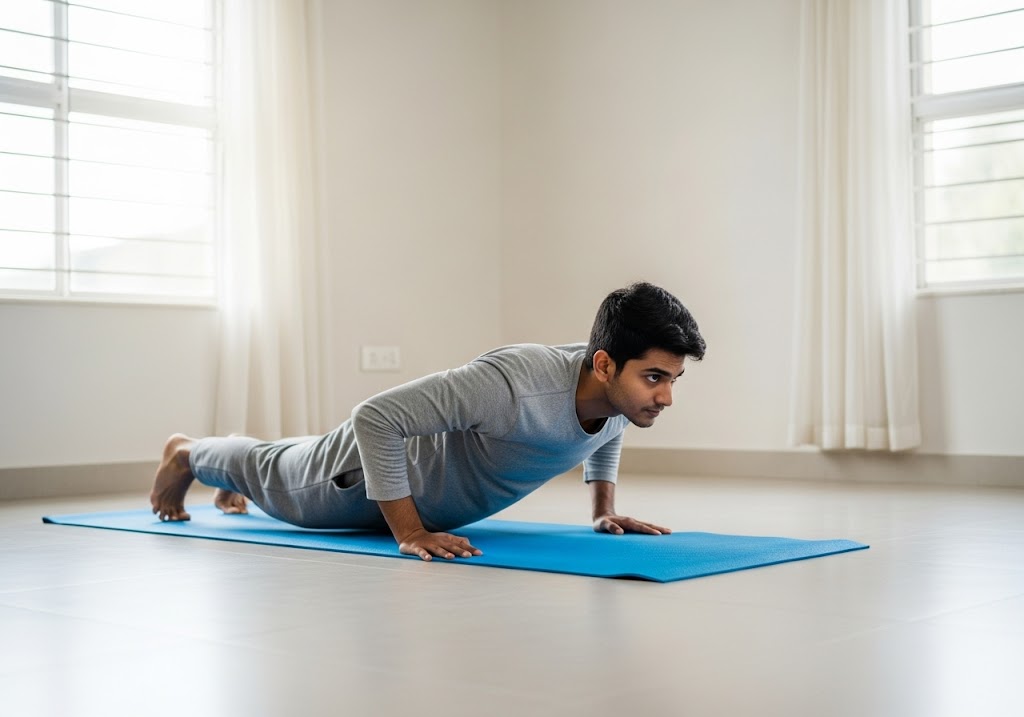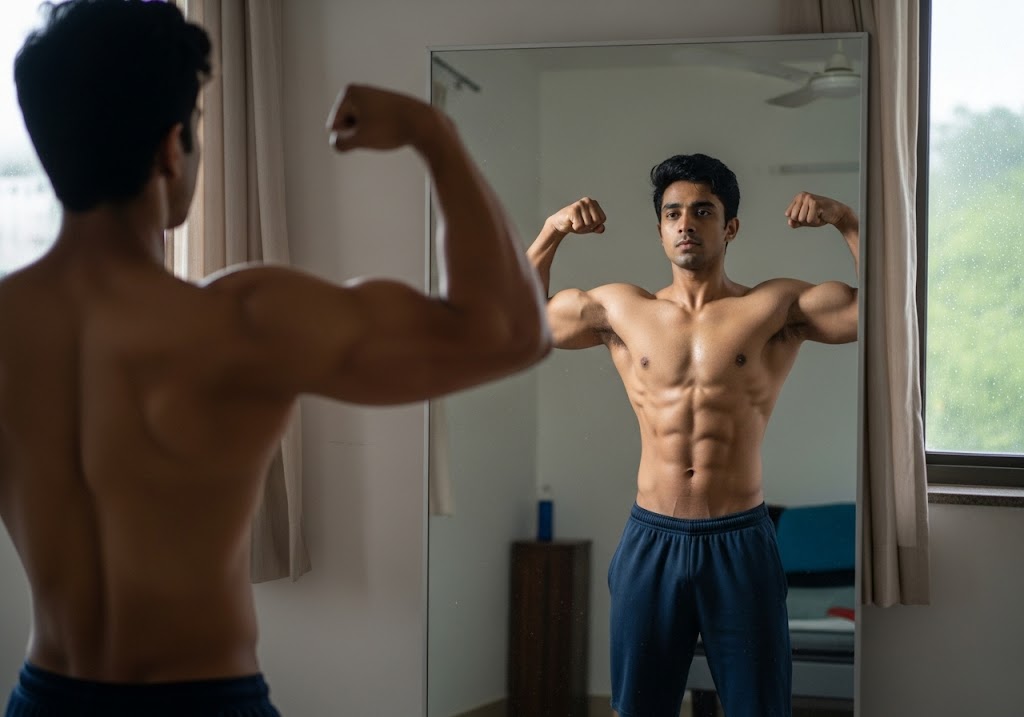The 8 bodyweight exercises for beginners are: push-ups for chest and triceps, squats for legs and glutes, planks for core strength, lunges for balance and lower body, glute bridges for hamstrings and glutes, mountain climbers for full-body cardio, burpees for endurance and coordination, and pull-ups for back and biceps & more.
Discovering bodyweight exercises for beginners opens the door to effective, equipment-free fitness that can be done anywhere, anytime. These fundamental movements use your body weight as resistance to build strength, endurance, and muscle while improving overall fitness. Learning bodyweight exercises for beginners provides an accessible foundation for lifelong health and wellness. Whether you’re starting your fitness journey or looking for convenient home workouts, bodyweight exercises for beginners offer incredible versatility and results. This complete guide will teach you everything needed to master bodyweight exercises for beginners, from basic movements to advanced progressions. Understanding bodyweight exercises for beginners properly ensures safe, effective training that grows with your abilities and delivers lasting transformation
Table of Contents
20 Bodyweight Exercises for Beginners Step by Step?
Mastering bodyweight exercises for beginners requires a systematic approach that builds strength, coordination, and confidence progressively. This step-by-step method ensures proper form development while preventing injury and maximizing results. Follow these proven steps to excel in bodyweight exercises for beginners safely and effectively. Mastering bodyweight exercises for beginners requires a systematic approach that builds strength, coordination, and confidence progressively. This step-by-step method ensures proper form development while preventing injury and maximizing results. These exercises require no equipment and can be performed anywhere, making them perfect for starting your fitness journey safely and effectively.
Beginner Bodyweight Exercise Overview
| Sr.No. | Exercise | Duration | Difficulty | Primary Focus | Equipment |
|---|---|---|---|---|---|
| 1 | Wall Push-ups | 3-5 minutes | Beginner | Upper body | Wall |
| 2 | Bodyweight Squats | 3-5 minutes | Beginner | Lower body | None |
| 3 | Modified Planks | 2-4 minutes | Beginner | Core | None |
| 4 | Stationary Lunges | 3-5 minutes | Beginner | Lower body | None |
| 5 | Glute Bridges | 2-4 minutes | Beginner | Glutes/Core | None |
| 6 | Wall Sits | 2-4 minutes | Beginner | Lower body | Wall |
| 7 | Standing Marching | 2-3 minutes | Beginner | Core/Balance | None |
| 8 | Calf Raises | 2-3 minutes | Beginner | Lower legs | None |
| 9 | Arm Circles | 2-3 minutes | Beginner | Shoulders | None |
| 10 | Knee Push-ups | 3-5 minutes | Beginner | Upper body | None |
| 11 | Chair-Assisted Squats | 3-4 minutes | Beginner | Lower body | Chair |
| 12 | Side Steps | 3-4 minutes | Beginner | Hips/Legs | None |
| 13 | Standing Side Bends | 2-3 minutes | Beginner | Core | None |
| 14 | Heel-to-Toe Walk | 2-3 minutes | Beginner | Balance | None |
| 15 | Mountain Climbers | 2-4 minutes | Intermediate | Core/Cardio | None |
| 16 | Standard Push-ups | 3-5 minutes | Intermediate | Upper body | None |
| 17 | Walking Lunges | 3-5 minutes | Intermediate | Lower body | None |
| 18 | Standard Planks | 2-4 minutes | Intermediate | Core | None |
| 19 | Step-ups | 3-5 minutes | Intermediate | Lower body | Step/Box |
| 20 | Burpees (Modified) | 3-5 minutes | Intermediate | Full body | None |
Detailed Exercise Instructions
1. Wall Push-ups
Wall push-ups provide the perfect introduction to pushing movements while building upper body strength gradually. This exercise teaches proper push-up form and alignment without the challenge of supporting full body weight. The standing position makes wall push-ups accessible to all fitness levels while effectively targeting chest, shoulders, and tricep muscles for foundational strength development.
How to Do Wall Push-ups?
- Stand arm’s length from wall with feet hip-width apart, place palms flat against wall at shoulder height
- Lean forward and push back using arm strength while keeping body straight from head to heels
- Start with 8-12 repetitions, focusing on controlled movement and proper alignment throughout
2. Bodyweight Squats
Bodyweight squats teach fundamental lower body movement patterns while building strength in quadriceps, glutes, and calves safely. This exercise mimics daily activities like sitting and standing, making it essential for functional fitness and mobility maintenance. Proper squat form creates foundation for more advanced lower body exercises while improving hip and ankle flexibility through natural movement patterns.
How to Do Bodyweight Squats?
- Stand with feet shoulder-width apart, toes slightly pointed outward for natural alignment
- Lower by pushing hips back and bending knees while keeping chest up and core engaged
- Descend until thighs are parallel to ground or comfortable depth, then drive through heels to stand
3. Modified Planks
Modified planks introduce core strengthening through isometric holds while accommodating beginner strength levels effectively. This exercise builds deep abdominal strength and teaches proper spinal alignment essential for all fitness activities. Starting with knee planks allows gradual progression to full planks while developing the core stability necessary for more advanced exercises.
How to Do Modified Planks?
- Start on hands and knees, then lower to forearms while keeping knees on ground
- Maintain straight line from head to knees, engaging core muscles throughout hold
- Begin with 15-30 second holds, gradually increasing duration as strength improves
4. Stationary Lunges
Stationary lunges develop single-leg strength and balance while teaching proper lunge mechanics in a controlled position. This exercise addresses muscle imbalances between legs while building functional strength for daily activities. The stationary position allows focus on proper form and depth without the balance challenges of moving lunges, making it perfect for beginners.
How to Do Stationary Lunges?
- Stand with one foot forward and one back in lunge stance, hands on hips for balance
- Lower straight down until both knees form 90-degree angles, keeping front knee over ankle
- Push through front heel to return to starting position, complete all reps before switching legs
5. Glute Bridges
Glute bridges activate and strengthen the glute muscles while teaching proper hip extension patterns essential for posture and lower back health. This exercise counteracts the effects of prolonged sitting while building strength in often-weak posterior chain muscles. The lying position makes glute bridges accessible while providing excellent muscle activation for beginners starting their fitness journey.
How to Do Glute Bridges?
- Lie on back with knees bent and feet flat on floor, arms at sides for stability
- Squeeze glutes and push through heels to lift hips, creating straight line from knees to shoulders
- Hold briefly at top position, then lower with control back to starting position
Find out how many calories do burpees burn.
6. Wall Sits
Wall sits build isometric leg strength and muscular endurance while teaching proper squat positioning with wall support. This exercise develops mental toughness alongside physical strength through sustained muscle contraction. Wall sits are excellent for building leg strength foundation while being low-impact and accessible to beginners of all fitness levels and abilities.
How to Do Wall Sits?
- Stand with back against wall, slide down until thighs are parallel to ground with knees at 90 degrees
- Keep back pressed against wall and weight evenly distributed across both feet
- Hold position for 15-45 seconds initially, gradually increasing duration as strength improves
7. Standing Marching
Standing marching improves balance, coordination, and core stability while being accessible to all fitness levels safely. This exercise activates hip flexors and core muscles while challenging proprioception and single-leg stability. Standing marching serves as excellent warm-up activity while building fundamental movement skills necessary for more complex exercises and daily activities.
How to Do Standing Marching?
- Stand tall with hands on hips or extended for balance, engage core muscles throughout
- Lift one knee toward chest to hip level, hold briefly, then lower with control
- Alternate legs in marching pattern, focusing on balance and controlled movement rather than speed
8. Calf Raises
Calf raises strengthen the lower leg muscles while improving ankle stability and balance essential for walking and running activities. This simple exercise can be performed anywhere and helps prevent common ankle injuries while building strength in often-neglected calf muscles. Calf raises also improve circulation in the lower legs and contribute to better overall leg function.
How to Do Calf Raises?
- Stand with feet hip-width apart, hands on wall or chair for balance if needed
- Rise up onto balls of feet by contracting calf muscles, hold briefly at top
- Lower heels back to ground with control, maintaining balance throughout movement
9. Arm Circles
Arm circles improve shoulder mobility and circulation while serving as excellent warm-up exercise for upper body activities. This gentle movement helps maintain shoulder joint health while preparing muscles for more demanding exercises. Arm circles are particularly beneficial for people who spend long hours at desks, helping counteract forward shoulder posturing and stiffness.
How to Do Arm Circles?
- Stand with arms extended to sides at shoulder height, maintaining good posture
- Make small circles forward for 30 seconds, then reverse direction for 30 seconds
- Gradually increase circle size while maintaining control and proper shoulder positioning
10. Knee Push-ups
Knee push-ups bridge the gap between wall push-ups and standard push-ups while building upper body strength progressively. This modification reduces body weight load while maintaining proper push-up movement patterns and muscle activation. Knee push-ups allow beginners to develop strength and confidence before progressing to more challenging push-up variations safely and effectively.
How to Do Knee Push-ups?
- Start in plank position on knees and hands, maintaining straight line from head to knees
- Lower chest toward ground by bending elbows, keeping core engaged throughout movement
- Push back to starting position with control, focusing on proper form over repetition count
Master how to do plank exercise properly.
11. Chair-Assisted Squats
Chair-assisted squats provide support and confidence while learning proper squat mechanics and building leg strength gradually. The chair serves as safety net and depth guide while allowing focus on movement quality rather than balance concerns. This progression helps beginners develop strength and coordination necessary for unassisted squats while maintaining proper form and safety.
How to Do Chair-Assisted Squats?
- Stand in front of chair with back toward seat, feet shoulder-width apart
- Lower slowly until lightly touching chair seat, then immediately stand back up
- Use chair for depth reference only, not full sitting, focusing on leg strength development
12. Side Steps
Side steps activate hip abductor muscles while improving lateral movement patterns often neglected in daily activities. This exercise helps prevent knee injuries by strengthening muscles that provide knee stability during movement. Side steps also improve balance and coordination while being gentle enough for beginners to perform safely and effectively.
How to Do Side Steps?
- Stand with feet together, take wide step to right while keeping toes pointed forward
- Bring left foot to meet right foot, then step to left and bring right foot over
- Continue stepping side to side, maintaining upright posture and controlled movement throughout
13. Standing Side Bends
Standing side bends target oblique muscles while improving spinal mobility and lateral strength patterns. This exercise helps counteract the forward-focused movements of daily life while building core strength through the frontal plane. Side bends are gentle introduction to core training while being accessible to beginners of all fitness levels.
How to Do Standing Side Bends?
- Stand with feet hip-width apart, one hand on hip and other extended overhead
- Bend sideways toward hand on hip, creating stretch along opposite side
- Return to center with control, complete all repetitions before switching sides
14. Heel-to-Toe Walk
Heel-to-toe walking improves balance, coordination, and proprioception while building confidence in single-leg stability. This exercise challenges the balance system while being safe and accessible for beginners. Balance training helps prevent falls and improves overall movement quality while building foundation for more complex exercises requiring stability and coordination.
How to Do Heel-to-Toe Walk?
- Walk forward placing heel of front foot directly in front of toes of back foot
- Focus on maintaining balance while moving slowly and deliberately forward
- Use wall or rail for light support if needed, gradually reducing assistance as balance improves
15. Mountain Climbers
Mountain climbers combine core strengthening with cardiovascular conditioning while teaching coordination between upper and lower body movements. This exercise elevates heart rate while building core endurance and shoulder stability. Mountain climbers serve as excellent transition to more intense exercises while providing comprehensive fitness benefits through dynamic movement patterns.
How to Do Mountain Climbers?
- Start in plank position with hands under shoulders and body in straight line
- Alternate driving knees toward chest while maintaining plank position and stable upper body
- Begin with slow, controlled movement focusing on form before increasing speed or intensity
Discover do crunches burn belly fat.
16. Standard Push-ups
Standard push-ups represent progression from modified versions while building significant upper body strength and core stability. This classic exercise engages chest, shoulders, triceps, and core muscles through functional movement patterns. Push-ups require no equipment while providing excellent strength building benefits and serving as benchmark for upper body fitness development.
How to Do Standard Push-ups?
- Start in plank position with hands slightly wider than shoulders, body straight from head to heels
- Lower chest toward ground by bending elbows, maintaining core engagement throughout movement
- Push back to starting position with control, focusing on quality over quantity of repetitions
17. Walking Lunges
Walking lunges add dynamic movement to lunge patterns while challenging balance, coordination, and unilateral leg strength simultaneously. This exercise builds functional strength through movement patterns used in daily activities while improving hip flexibility and stability. Walking lunges progress naturally from stationary versions while adding coordination challenges and continuous movement benefits.
How to Do Walking Lunges?
- Start standing, step forward into lunge position with front thigh parallel to ground
- Push through front heel to bring back foot forward into next lunge position
- Continue alternating legs in walking pattern, maintaining proper lunge depth and alignment throughout
18. Standard Planks
Standard planks progress from modified versions while building exceptional core strength and stability through isometric training. This exercise teaches total-body tension and proper spinal alignment while strengthening deep stabilizing muscles. Planks transfer to improved posture and reduced back pain while serving as foundation for more advanced core training exercises.
How to Do Standard Planks?
- Start in forearm plank position with elbows under shoulders and body straight from head to heels
- Engage all core muscles while maintaining neutral spine and steady breathing
- Hold position for 30-60 seconds or as long as perfect form can be maintained
19. Step-ups
Step-ups build single-leg strength while mimicking daily activities like climbing stairs, making them highly functional for beginners. This exercise addresses muscle imbalances while improving balance and coordination through controlled movement patterns. Step-ups can be adjusted for difficulty through step height while providing excellent strength building benefits for lower body development.
How to Do Step-ups?
- Stand facing sturdy step or platform, place entire right foot on step surface
- Step up by pushing through right heel, bringing left foot up to meet right
- Step down with control, leading with same foot that stepped up first
20. Modified Burpees
Modified burpees introduce full-body conditioning while being accessible to beginners through movement modifications and intensity control. This exercise combines strength and cardiovascular training while teaching coordination between multiple movement patterns. Modified versions allow gradual progression to standard burpees while providing comprehensive fitness benefits and building confidence in complex movements.
How to Do Modified Burpees?
- Start standing, step back into plank position rather than jumping back
- Perform knee push-up or hold plank, then step feet back toward hands
- Stand up with control rather than jumping, focusing on movement quality over speed
Explore the full list of Jumping Jacks Exercise Benefits and see why this classic cardio move still works wonders. Learn the truth about does sit ups increase height.
20-Minute Bodyweight Workout for Beginners
This beginner-friendly bodyweight workout requires no equipment and can be done anywhere. Perfect for building strength, improving cardiovascular health, and establishing a consistent exercise routine. Focus on proper form over speed, and modify exercises as needed to match your current fitness level.
Beginner Tips
- Start with 2-3 workouts per week
- Listen to your body and rest when needed
- Drink water throughout the workout
- Progress gradually by increasing duration or adding reps
Workout Schedule
| Phase | Exercise | Duration/Reps | Rest | Notes |
| Warm-Up | Arm Circles | 30 seconds each direction | – | Start small, gradually increase size |
| Leg Swings | 10 each leg, each direction | – | Hold wall for balance if needed | |
| Marching in Place | 1 minute | – | Lift knees to comfortable height | |
| Bodyweight Squats | 10 slow reps | – | Focus on form, go to comfortable depth | |
| Main Workout | Modified Push-ups | 30 seconds | 30 seconds | Use knees or wall if needed |
| Bodyweight Squats | 45 seconds | 15 seconds | Control the movement | |
| Plank Hold | 20-30 seconds | 30 seconds | On knees if needed | |
| Lunges (Alternating) | 30 seconds | 30 seconds | Use chair for balance | |
| Mountain Climbers | 30 seconds | 30 seconds | Slow and controlled | |
| Wall Sits | 20-30 seconds | 30 seconds | Back against wall | |
| Modified Burpees | 30 seconds | 30 seconds | Step back instead of jumping | |
| Glute Bridges | 45 seconds | 15 seconds | Squeeze glutes at top | |
| Repeat Main Circuit | – | – | – | Complete the main workout twice |
| Cool-Down | Deep Breathing | 1 minute | – | In through nose, out through mouth |
| Forward Fold Stretch | 30 seconds | – | Gentle, don’t force | |
| Shoulder Rolls | 30 seconds | – | Backwards and forwards | |
| Gentle Neck Stretches | 30 seconds | – | Side to side, hold gently |
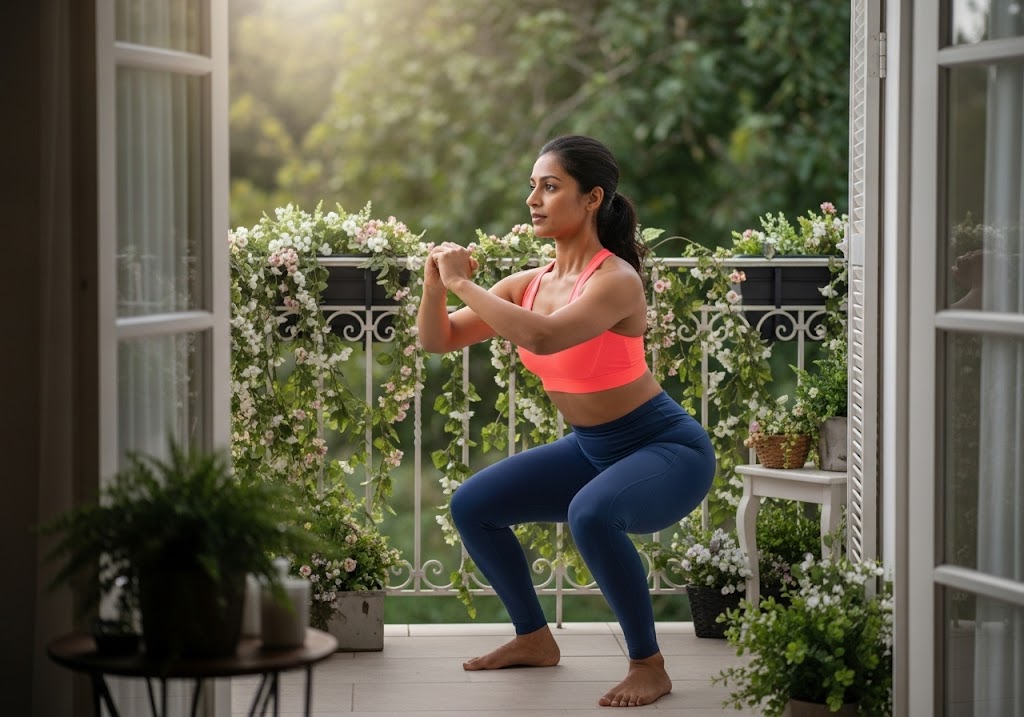
What are Bodyweight Exercises for Beginners?
Bodyweight exercises for beginners are strength training movements that use your body weight as resistance instead of external weights or machines. These exercises provide an accessible, equipment-free way to build strength, endurance, and muscle while improving flexibility and coordination. Understanding bodyweight exercises for beginners is essential for anyone starting their fitness journey or looking to train at home without equipment.
The beauty of bodyweight exercises for beginners lies in their scalability and convenience. You can perform these movements anywhere, from your living room to a park, making them perfect for busy lifestyles. These exercises teach proper movement patterns while building functional strength that translates to daily activities. Learning how to start calisthenics often begins with mastering basic bodyweight exercises for beginners.
Bodyweight Exercises for Beginners: Upper, Lower & Full Body Workouts
Bodyweight training offers the perfect entry point into fitness, requiring zero equipment while building functional strength. These exercises use your own weight as resistance, improving mobility, stability, and muscle endurance. Perfect for home workouts, they progress naturally as you get stronger, making fitness accessible anywhere, anytime.
Discover how to burn 500 calories at home without equipment using bodyweight exercises that really work.
Upper Body Bodyweight Exercises for Beginners
Transform your upper body strength without weights through these foundational movements. From basic push-ups to unique variations, these exercises target chest, shoulders, triceps, and back muscles. Progress gradually through modifications, building the foundation for advanced bodyweight skills while developing functional pushing and pulling strength.
| Exercise | Difficulty | Sets x Reps | Description |
|---|---|---|---|
| Wall Push-ups | Beginner | 2 x 8-12 | Stand arm’s length from wall, push against it |
| Incline Push-ups | Beginner | 2 x 6-10 | Hands on elevated surface, feet on ground |
| Knee Push-ups | Beginner | 2 x 5-8 | Standard push-up from knees |
| Hindu Push-ups | Intermediate | 2 x 4-6 | Flowing movement: downward dog to cobra pose |
| Pike Push-ups | Intermediate | 2 x 3-5 | Inverted V position, targets shoulders |
| Archer Push-ups | Advanced | 1 x 2-4 each side | One-arm emphasis push-up variation |
| Bear Crawl Hold | Beginner | 2 x 15-30 sec | Tabletop position with knees hovering |
| Tricep Dips (Chair) | Beginner | 2 x 5-8 | Hands on chair edge, dip down and up |
Explore the full list of Jumping Jacks Exercise Benefits to boost your cardio, coordination, and calorie burn.
Lower Body Bodyweight Exercises for Beginners
Build powerful legs and glutes through these fundamental lower body movements. From basic squats to challenging single-leg variations, these exercises develop balance, coordination, and strength. Master proper form first, then progress to more dynamic and unilateral movements for complete lower body development.
| Exercise | Difficulty | Sets x Reps | Description |
|---|---|---|---|
| Bodyweight Squats | Beginner | 2 x 10-15 | Basic squat to parallel or below |
| Wall Sit | Beginner | 2 x 20-45 sec | Back against wall, thighs parallel to floor |
| Reverse Lunges | Beginner | 2 x 6-10 each leg | Step back into lunge position |
| Cossack Squats | Intermediate | 2 x 4-6 each side | Deep side lunge with straight leg |
| Single-leg Glute Bridges | Intermediate | 2 x 5-8 each leg | Bridge with one leg extended |
| Shrimp Squats | Advanced | 1 x 1-3 each leg | Single-leg squat with rear leg bent behind |
| Frog Jumps | Beginner | 2 x 5-8 | Deep squat position, jump forward |
| Calf Raises | Beginner | 2 x 12-20 | Rise up on toes, control descent |
Find out how much to run to burn 500 calories based on your pace, weight, and goals.
Full Body Bodyweight Exercises for Beginners
Maximize your workout efficiency with these compound movements that engage multiple muscle groups simultaneously. These exercises improve cardiovascular fitness while building total-body strength and coordination. Perfect for time-efficient workouts, they challenge your body in multiple planes of movement for functional fitness development.
| Exercise | Difficulty | Sets x Reps | Description |
|---|---|---|---|
| Jumping Jacks | Beginner | 2 x 15-25 | Classic cardio movement |
| Modified Burpees | Beginner | 2 x 3-5 | Step back/forward instead of jumping |
| Mountain Climbers | Beginner | 2 x 10-20 | Plank position, alternate knee drives |
| Turkish Get-ups | Intermediate | 1 x 2-3 each side | Complex movement from lying to standing |
| Bear Crawls | Intermediate | 2 x 10-15 steps | Crawl forward keeping knees off ground |
| Lizard Crawls | Intermediate | 2 x 8-12 steps | Low crawl, army-style movement |
| Inchworms | Beginner | 2 x 5-8 | Walk hands out to plank, walk feet to hands |
| Star Jumps | Beginner | 2 x 8-12 | Jumping jack with arms and legs wide |
Benefits of Bodyweight Exercises for Beginners
Incorporating bodyweight exercises for beginners into your fitness routine provides numerous physical and mental benefits that extend far beyond simple strength building. These exercises offer a complete fitness solution that improves multiple aspects of health and wellness simultaneously.
- No Equipment Required: Bodyweight exercises for beginners need no gym membership or expensive equipment
- Builds Functional Strength: Develops strength that directly applies to daily activities and movements
- Improves Flexibility: Many movements enhance mobility and range of motion naturally
- Enhances Coordination: Multi-joint exercises improve balance and body awareness significantly
- Scalable Difficulty: Easily modified for any fitness level or physical limitation
- Time Efficient: Complete full-body workouts in 20-30 minutes effectively
- Injury Prevention: Natural movement patterns reduce risk of exercise-related injuries
- Mental Benefits: Builds confidence, reduces stress, and improves mood consistently
Find out how many planks should I do a day to build endurance and stability the smart way.
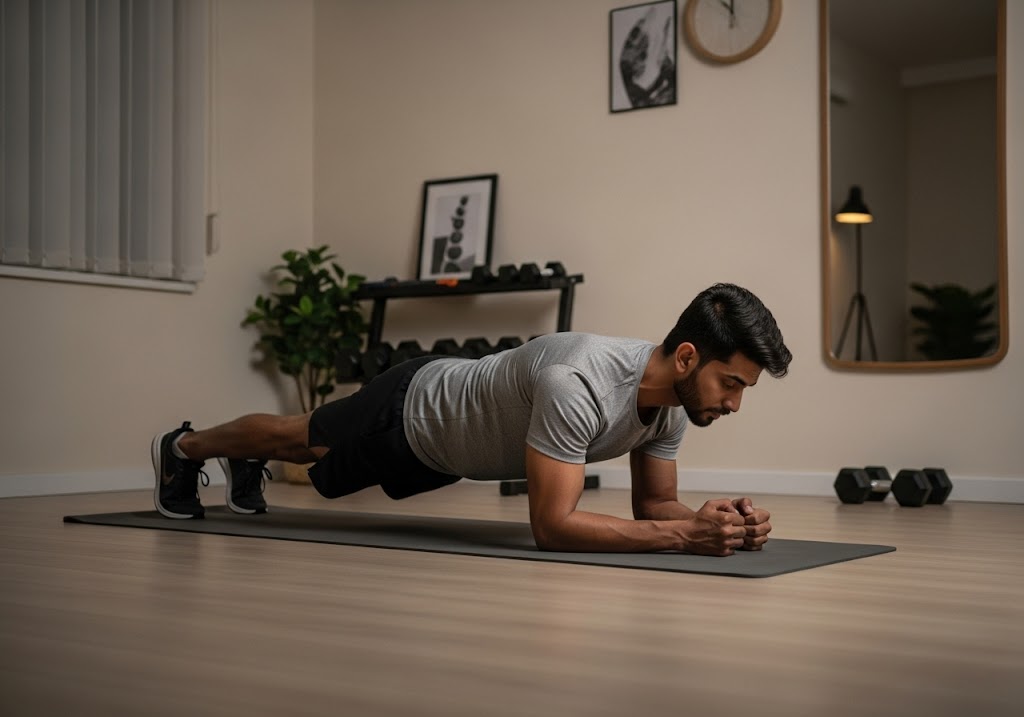
Best Bodyweight Exercises for Beginners
Understanding the best bodyweight exercises for beginners ensures you focus on movements that provide maximum benefit while building a solid foundation. These exercises target all major muscle groups and can be modified to match your current fitness level perfectly.
| Exercise | Primary Muscles | Difficulty | Modifications |
| Push-ups | Chest, shoulders, triceps | Beginner | Wall → Knee → Standard → Decline |
| Squats | Legs, glutes, core | Beginner | Chair assist → Bodyweight → Jump |
| Planks | Core, shoulders | Beginner | Knee → Standard → Side → Extended |
| Lunges | Legs, glutes, balance | Beginner | Stationary → Walking → Reverse |
| Glute Bridges | Glutes, hamstrings | Beginner | Standard → Single-leg → Elevated |
| Mountain Climbers | Full body, cardio | Intermediate | Slow → Fast → Cross-body |
| Burpees | Full body, power | Intermediate | Step-back → Jump → Advanced |
| Dead Bugs | Core, coordination | Beginner | Single limb → Opposite limbs |
Learn how to burn 500 calories a day with effective workouts and smart habits that fit your lifestyle.
Bodyweight Chest Exercises for Beginners
Learning bodyweight chest exercises for beginners is crucial for developing upper body strength and muscle definition. These exercises target the pectorals while engaging supporting muscles for comprehensive chest development without equipment.
| Exercise | Technique | Progression | Benefits |
| Wall Push-ups | Stand arm’s length from wall, lean in and push back | Closer to wall → Standard distance | Builds initial push strength |
| Knee Push-ups | Knees on ground, maintain straight torso | Increase reps → Progress to full | Develops proper form |
| Standard Push-ups | Full plank position, lower chest to ground | Perfect form → Increased reps | Complete chest development |
| Incline Push-ups | Hands on elevated surface, push up | Higher → Lower elevation | Gradual strength building |
| Decline Push-ups | Feet elevated, hands on ground | Lower → Higher elevation | Upper chest emphasis |
| Diamond Push-ups | Hands form diamond shape under chest | Standard → Diamond grip | Tricep and inner chest focus |
Explore Somatic Pilates to improve body awareness, release tension, and enhance recovery.
Bodyweight Core Exercises for Beginners
Mastering bodyweight core exercises for beginners is essential for developing trunk stability, improving posture, and preventing lower back pain. These exercises target all core muscles while building the foundation for advanced movements.
| Exercise | Technique | Duration | Benefits |
| Plank | Forearms down, straight body line | 15-60 seconds | Overall core stability |
| Side Plank | On side, support body on forearm | 10-30 seconds each side | Lateral core strength |
| Dead Bug | Lying down, opposite arm/leg moves | 10-15 reps each side | Core coordination |
| Bird Dog | Hands/knees, extend opposite limbs | 10-15 reps each side | Core and back stability |
| Hollow Body Hold | Lying down, lift shoulders and legs | 10-30 seconds | Deep core activation |
| Bicycle Crunches | Lying down, alternating elbow to knee | 15-20 reps each side | Rotational core strength |
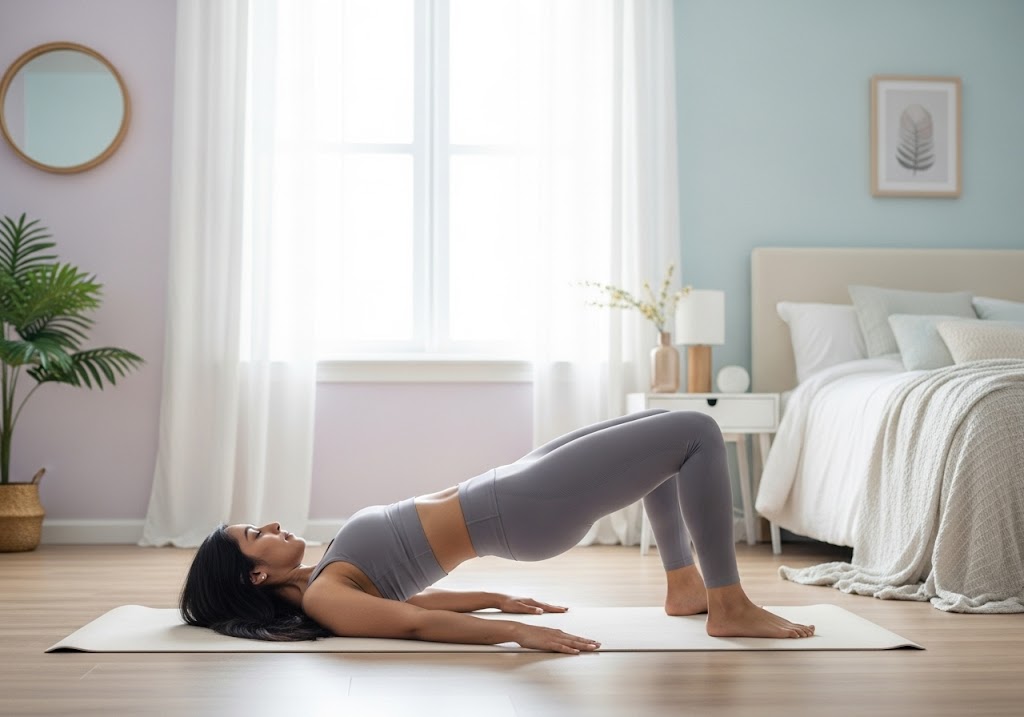
Bodyweight Bicep Exercises for Beginners
Developing bodyweight bicep exercises for beginners can be challenging since biceps primarily pull, but creative exercises can effectively target these muscles. These movements build arm strength while improving functional pulling patterns.
| Exercise | Technique | Difficulty | Equipment |
| Chin-ups (Assisted) | Underhand grip, assistance with bands | Intermediate | Pull-up bar, resistance band |
| Inverted Rows | Lying under bar, pull chest up | Beginner | Sturdy table or bar |
| Reverse Plank | Sitting, hands behind, lift hips | Beginner | Floor space |
| Pike Push-ups | Downward dog, lower head to ground | Intermediate | Floor space |
| Towel Isometric Curls | Towel under foot, curl against resistance | Beginner | Towel |
| Wall Sits with Arm Curls | Wall sit position, simulate curls | Beginner | Wall space |
Bodyweight Leg Exercises for Beginners
Bodyweight leg exercises provide safe, effective lower body strengthening without requiring equipment or gym memberships. These movements build functional strength through natural movement patterns while improving balance, mobility, and coordination. Beginning with proper form and gradual progression prevents injury while establishing foundation strength necessary for daily activities and more advanced training.
Beginner Leg Exercise Program
| Exercise | Sets | Reps/Duration | Rest | Primary Target | Difficulty | Equipment |
|---|---|---|---|---|---|---|
| Chair-Assisted Squats | 2-3 | 8-12 reps | 30-45 sec | Quads, Glutes | Beginner | Chair |
| Wall Sits | 2-3 | 15-30 seconds | 45-60 sec | Quads, Glutes | Beginner | Wall |
| Stationary Lunges | 2-3 | 6-10 per leg | 30-45 sec | Quads, Glutes | Beginner | None |
| Calf Raises | 2-3 | 10-15 reps | 20-30 sec | Calves | Beginner | Wall (optional) |
| Glute Bridges | 2-3 | 8-12 reps | 30-45 sec | Glutes, Hamstrings | Beginner | None |
| Side Steps | 2-3 | 8-10 per side | 30-45 sec | Hip Abductors | Beginner | None |
| Standing Marching | 2-3 | 10-15 per leg | 20-30 sec | Hip Flexors, Core | Beginner | None |
| Heel-to-Toe Walk | 2-3 | 10-20 steps | 30-45 sec | Balance, Stabilizers | Beginner | None |
| Single-Leg Balance | 2-3 | 15-30 sec per leg | 30-45 sec | Stabilizers | Beginner | None |
| Bodyweight Squats | 2-3 | 5-10 reps | 45-60 sec | Quads, Glutes | Beginner+ | None |
Advanced Upper Body Bodyweight Workout
Advanced upper body bodyweight training challenges strength, power, and coordination through complex movement patterns requiring exceptional technique and conditioning. These exercises demand significant strength foundation and proper progression from intermediate movements. Advanced practitioners should prioritize perfect form over maximum repetitions while allowing adequate recovery between demanding sessions to prevent overuse injuries.
Advanced Upper Body Workout Program
| Exercise | Sets | Reps/Duration | Rest | Primary Target | Difficulty | Prerequisites |
|---|---|---|---|---|---|---|
| Handstand Push-ups | 3-4 | 3-8 reps | 2-3 min | Shoulders, Triceps | Expert | Wall handstand 60s |
| One-Arm Push-ups | 3-4 | 1-5 per arm | 2-3 min | Chest, Triceps, Core | Expert | 20+ standard push-ups |
| Muscle-ups | 3-4 | 1-3 reps | 2-3 min | Pull/Push combo | Expert | 10+ pull-ups, 15+ dips |
| Archer Push-ups | 3-4 | 3-6 per side | 90-120 sec | Chest, Triceps | Advanced | 15+ standard push-ups |
| Typewriter Pull-ups | 3-4 | 2-5 per side | 90-120 sec | Lats, Biceps | Advanced | 8+ pull-ups |
| Pike Push-ups | 3-4 | 8-12 reps | 60-90 sec | Shoulders, Triceps | Advanced | 20+ push-ups |
| Pseudo Planche Push-ups | 3-4 | 3-8 reps | 90-120 sec | Shoulders, Chest | Advanced | Planche lean 30s |
| Explosive Push-ups | 3-4 | 5-10 reps | 90-120 sec | Power, Chest | Advanced | 15+ push-ups |
| Commando Pull-ups | 3-4 | 4-8 reps | 90-120 sec | Lats, Core | Advanced | 8+ pull-ups |
| Human Flag Progressions | 3-4 | 10-20 sec holds | 2-3 min | Core, Shoulders | Expert | Advanced pulling strength |
Creating Your Bodyweight Workout Routine
Designing an effective routine with bodyweight exercises for beginners requires balancing different movement patterns, intensity levels, and recovery periods. A well-structured routine ensures consistent progress while preventing overtraining and maintaining motivation.
- Workout Frequency: Start with 3 sessions per week, allowing rest days for recovery
- Session Duration: Begin with 20-30 minutes including warm-up and cool-down
- Exercise Selection: Choose 6-8 exercises covering all major muscle groups
- Set and Rep Scheme: Perform 2-3 sets of 8-15 repetitions for most exercises
- Progressive Overload: Gradually increase difficulty through reps, sets, or exercise variations
- Recovery Planning: Schedule rest days and prioritize sleep for optimal adaptation
Learn how many sit ups to burn 1000 calories and what it really takes to hit that target.
Common Mistakes in Bodyweight Training
Understanding common errors in bodyweight exercises for beginners helps you avoid pitfalls that can slow progress or increase injury risk. These mistakes are particularly common when people rush through movements or neglect proper form development.
- Prioritizing Quantity Over Quality: Doing many poor repetitions instead of fewer perfect ones
- Skipping Warm-up: Starting intense exercise without proper preparation increases injury risk
- Ignoring Progression: Using same exercises without advancing difficulty or complexity
- Neglecting Form: Allowing form to break down as fatigue sets in
- Insufficient Recovery: Training too frequently without adequate rest periods
- Comparing to Others: Focusing on others’ performance rather than personal progress
- Avoiding Challenging Exercises: Staying in comfort zone instead of progressing
- Inconsistent Training: Sporadic workouts prevent necessary adaptations for improvement
Discover how many sit ups a day to lose belly fat – and what else you need for real results.
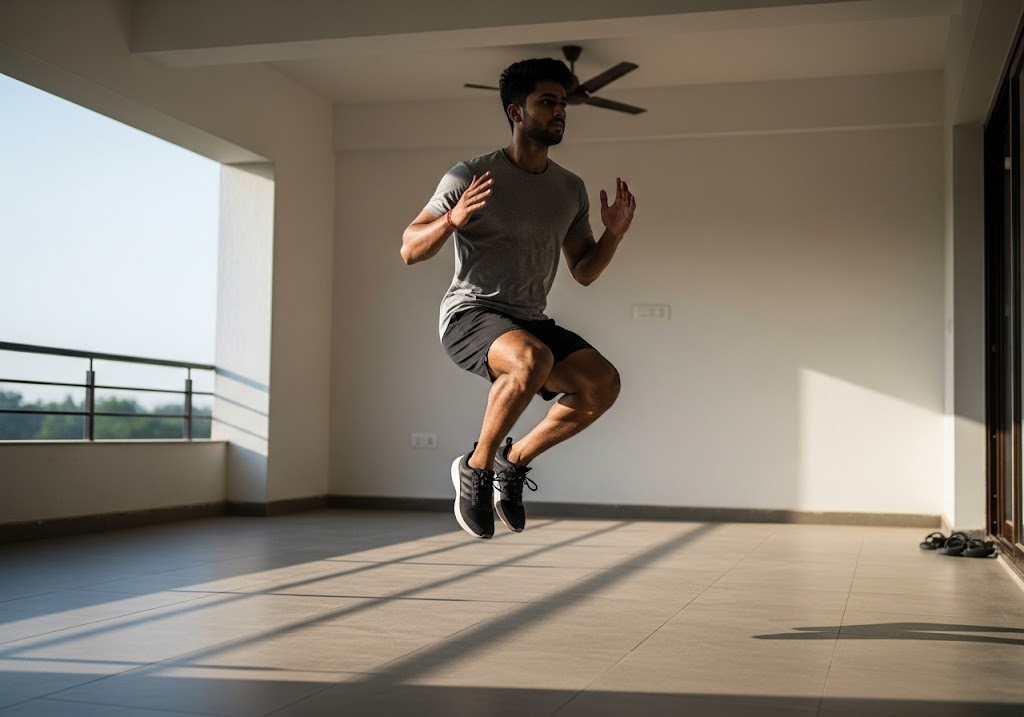
Advanced Bodyweight Considerations
As you progress in bodyweight exercises for beginners, consider incorporating more advanced movements and training principles. This progression ensures continued challenge and development as your strength and skills improve.
Understanding how bodyweight exercises for beginners connect to advanced skills like calisthenics planche helps you plan long-term training goals. These foundational movements prepare you for impressive advanced skills.
Many people wonder does calisthenics build muscle effectively. The answer is yes, and starting with proper bodyweight exercises for beginners ensures you maximize muscle building potential throughout your journey.
Nutritional Support for Bodyweight Training
Proper nutrition amplifies bodyweight training results by supporting muscle recovery and sustained energy levels. Focus on consuming adequate protein (0.8-1 gram per pound of body weight) to repair and build muscle tissue. Include complex carbohydrates like oats, quinoa, and sweet potatoes for sustained workout energy. Stay consistently hydrated throughout the day, aiming for clear or pale yellow urine as a hydration indicator.
Time your meals strategically around workouts for optimal performance and recovery. Eat a light snack containing carbohydrates 30-60 minutes before exercising to fuel your session. Within two hours post-workout, consume a balanced meal combining protein and carbohydrates to maximize muscle protein synthesis and replenish energy stores for your next training session.
Compare the benefits of each in cold shower vs hot shower and see which one suits your fitness routine best.
Home Training Environment for Bodyweight Training
Creating an effective home workout space requires minimal equipment but thoughtful setup. Designate a clear area at least 6×6 feet with adequate ceiling height for jumping movements. Invest in a quality exercise mat for floor exercises and ensure proper ventilation and lighting. Remove potential hazards like loose rugs or low furniture that could cause injury during dynamic movements.
Establish environmental cues that promote consistency and motivation in your home gym space. Keep workout clothes visible as a daily reminder, play energizing music, and maintain the area clutter-free. Consider using mirrors to check form and create a more gym-like atmosphere. Schedule specific workout times and treat your home space with the same respect you’d show a commercial gym.
The principles of calisthenics at home no equipment apply perfectly to bodyweight exercises for beginners. You can achieve excellent results with minimal space and equipment investment.
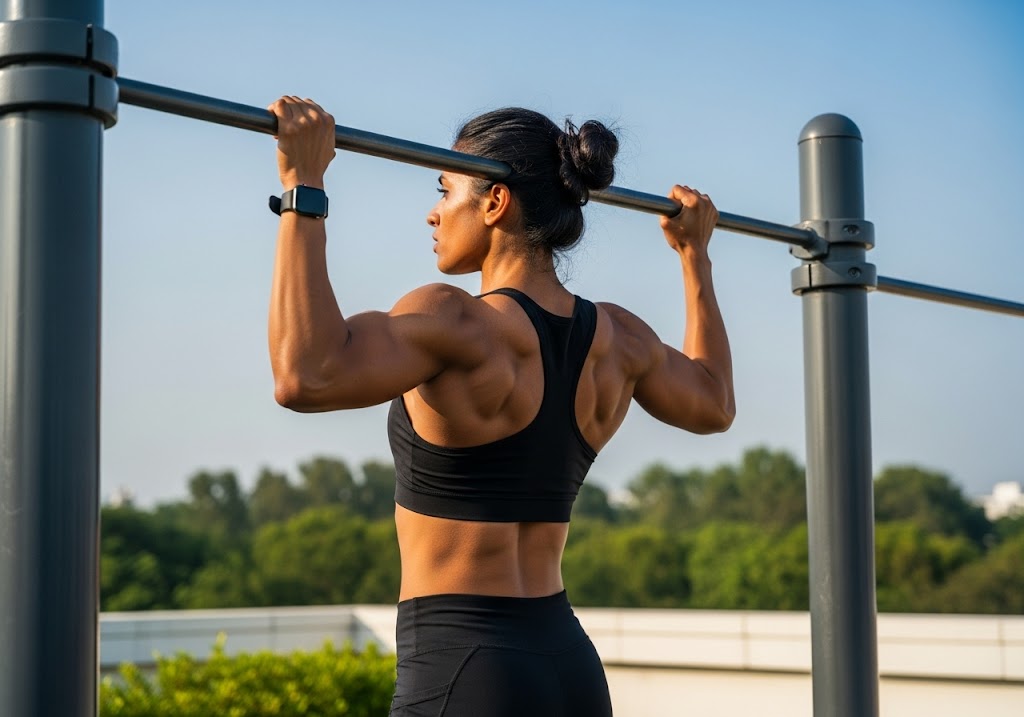
Injury Prevention and Safety in Bodyweight Exercises
Proper injury prevention begins with understanding your current fitness limitations and respecting them. Always perform dynamic warm-ups before exercising and static stretches afterward to prepare muscles and joints. Focus on controlled movements rather than explosive actions, especially when starting new exercises. Pay attention to pain versus normal muscle fatigue – sharp or persistent pain indicates potential injury requiring rest.
Environmental safety and proper form are crucial for long-term success. Ensure adequate space for movements and use non-slip surfaces to prevent falls. Learn correct exercise technique through reputable videos or instruction before increasing intensity. Progress gradually by adding 10-15% more repetitions or duration weekly, allowing your body time to adapt and strengthen safely.
Consider incorporating warm up exercises for beginners before every session to prepare your body properly. This preparation is crucial for safe and effective training.
Tracking Progress and Motivation in Bodyweight Exercises
Effective progress tracking transforms bodyweight training from random activity into purposeful development. Document your workouts using a simple journal or smartphone app, recording exercise duration, repetitions, and difficulty levels. Weekly progress photos and measurements provide visual motivation beyond numbers. Set achievable milestones like progressing from knee push-ups to full push-ups, or increasing plank hold time by 10-second intervals.
Maintain motivation through variety and community engagement. Rotate exercise routines weekly to prevent boredom and challenge different muscle groups. Join online fitness communities or find workout partners for accountability and encouragement. Reward yourself for consistency milestones with non-food treats like new workout clothes or fitness accessories.
This advanced calisthenics routine is perfect for building elite strength, control, and endurance.
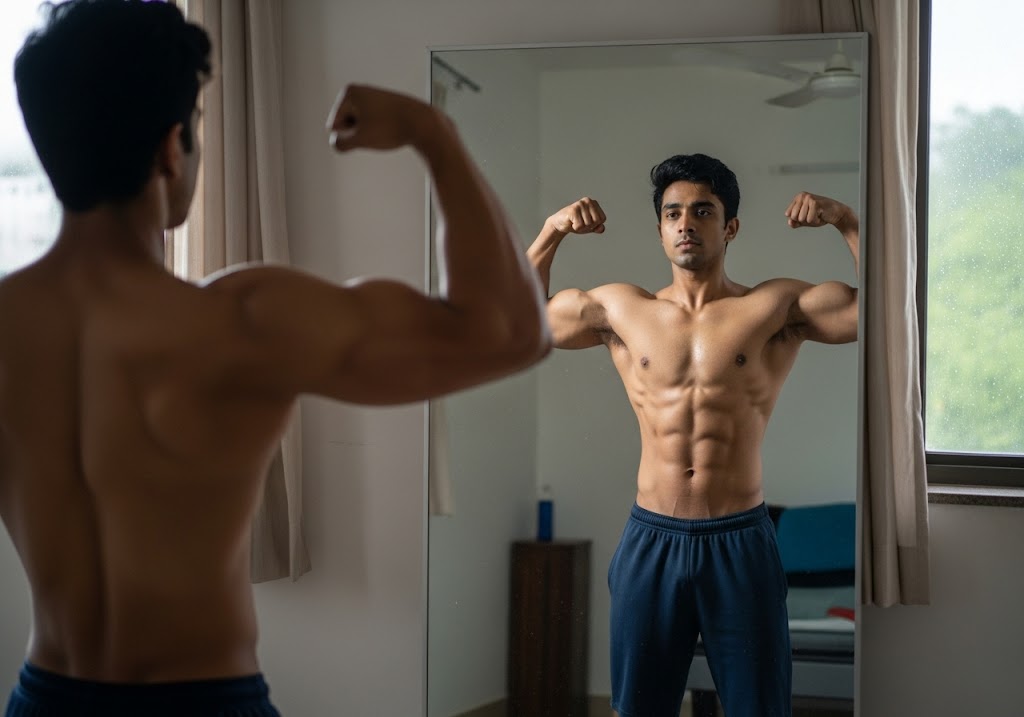
Bodyweight Exercises for Beginners: Specialized Training Applications
Bodyweight exercises offer versatile applications for specific training goals and circumstances. For rehabilitation purposes, modified movements like wall push-ups and assisted squats help rebuild strength after injury while maintaining joint mobility. Travel-friendly routines eliminate gym dependency, allowing consistent training anywhere. Office workers can integrate desk-based stretches and chair exercises to combat sedentary lifestyle effects throughout their workday.
Sport-specific adaptations make bodyweight training valuable for athletic development. Runners benefit from single-leg exercises that improve balance and prevent injury, while swimmers can focus on core-strengthening planks and rotational movements. Seniors can utilize low-impact variations emphasizing balance and flexibility. These specialized applications demonstrate how basic bodyweight movements can be tailored to meet diverse fitness needs and life circumstances.
Consider exploring specialized areas like back calisthenics exercises or calisthenics pull workout routines as you advance. These specializations build on your foundation of bodyweight exercises for beginners.
Building Long-term Success for Bodyweight Exercises for Beginners
Building sustainable success with bodyweight exercises starts with consistency over intensity. Begin with realistic goals and focus on proper form rather than speed or quantity. Gradually increase workout frequency from 2-3 times weekly to daily sessions as your strength improves. Track your progress by noting increased reps, longer hold times, or advancing to more challenging exercise variations.
Creating lasting habits requires patience and self-compassion. Listen to your body’s signals and allow adequate recovery time between sessions. Celebrate small victories like completing your first full push-up or holding a plank for 60 seconds. Remember that sustainable fitness is a lifelong journey, not a quick fix.
The journey from bodyweight exercises for beginners to advanced calisthenics skills is rewarding and achievable. Understanding calisthenics vs gymnastics differences helps you choose the right path for your goals.
Conclusion
Mastering bodyweight exercises for beginners provides an excellent foundation for lifelong fitness success. These versatile movements build strength, endurance, and coordination while requiring no equipment or gym membership. With proper progression, consistent practice, and attention to form, bodyweight exercises for beginners can transform your physique and health. Start implementing these exercises today and experience the incredible benefits of equipment-free training. Your body is the only gym you need for remarkable results.
Want to master the calisthenics handstand and take your skills to the next level? Whether you’re a beginner or pushing advanced skills, ISC – Indian School of Calisthenics offers expert guidance to help you master bodyweight training. Visit us at SRPF Ground, NH8, Goregaon (E), Mumbai – 400065. For class schedules, personalized coaching, or more details, call +91 77159 53218. Train smart, move better, and unlock your back strength with ISC.
Bodyweight Exercises for Beginners – FAQs
What are the best bodyweight exercises for beginners to start with?
Start with push-ups, squats, planks, lunges, and glute bridges. These exercises target all major muscle groups and can be modified for any fitness level.
Can bodyweight exercises for beginners build muscle effectively?
Yes, bodyweight exercises for beginners can build significant muscle mass through progressive overload, proper nutrition, and consistent training over time.
How often should beginners do bodyweight exercises?
Beginners should perform bodyweight exercises 3-4 times per week, allowing rest days for recovery and muscle growth between training sessions.
Do I need equipment for bodyweight exercises for beginners?
No, bodyweight exercises for beginners require no equipment. Your body weight provides all the resistance needed for effective strength training.
How long should a beginner bodyweight workout last?
Beginner bodyweight workouts should last 20-30 minutes including warm-up and cool-down. Focus on quality over quantity for best results.
Are bodyweight exercises for beginners effective for weight loss?
Yes, bodyweight exercises for beginners burn calories while building muscle, boosting metabolism and promoting fat loss when combined with proper nutrition.
Can I do bodyweight exercises for beginners at home?
Absolutely! Bodyweight exercises for beginners are perfect for home training, requiring minimal space and no equipment for effective workouts.
How do I progress in bodyweight exercises for beginners?
Progress by increasing repetitions, adding sets, trying harder variations, or learning new exercises. Advance gradually while maintaining proper form.
What muscles do bodyweight exercises for beginners work?
Bodyweight exercises for beginners work all major muscle groups including chest, back, shoulders, arms, core, and legs for complete body development.
Are bodyweight exercises for beginners suitable for all ages?
Yes, bodyweight exercises for beginners can be modified for all ages and fitness levels, making them accessible for everyone with proper guidance.
